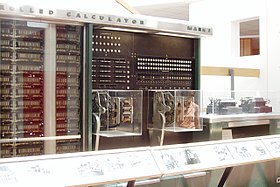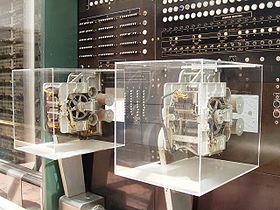Harvard Mark I: Difference between revisions
m Reverted edit(s) by 24.159.220.115 identified as test/vandalism using STiki |
|||
| Line 86: | Line 86: | ||
| accessdate = April 23, 2011 |
| accessdate = April 23, 2011 |
||
}} |
}} |
||
* [http:// |
* [http://purl.umn.edu/107348 Oral history interview with Robert Hawkins] at [[Charles Babbage Institute]], University of Minnesota, Minneapolis. Hawkins discusses the Harvard-IBM Mark I project that he worked on at Harvard University as a technician as well as [[Howard Aiken]]'s leadership of the project. |
||
* [http:// |
* [http://purl.umn.edu/107123 Oral history interview with Richard M. Bloch] at [[Charles Babbage Institute]], University of Minnesota, Minneapolis. Bloch describes his work at the Harvard Computation Laboratory for [[Howard Aiken]] on the Mark I. |
||
* [http:// |
* [http://purl.umn.edu/107210 Oral history interview with Robert V. D. Campbell] at [[Charles Babbage Institute]], University of Minnesota, Minneapolis. Campbell discusses the contributions of Harvard and IBM to the Mark I project. |
||
* [http://www-1.ibm.com/ibm/history/exhibits/markI/markI_reference.html IBM Archive: IBM ASCC Reference Room] |
* [http://www-1.ibm.com/ibm/history/exhibits/markI/markI_reference.html IBM Archive: IBM ASCC Reference Room] |
||
* [http://www.bitsavers.org/pdf/harvard/MarkI_operMan_1946.pdf ASCC operational manual] (PDF) |
* [http://www.bitsavers.org/pdf/harvard/MarkI_operMan_1946.pdf ASCC operational manual] (PDF) |
||
Revision as of 18:24, 30 March 2012



The IBM Automatic Sequence Controlled Calculator (ASCC), called the Mark I by Harvard University,[1] was an electro-mechanical computer.
The electromechanical ASCC was devised by Howard H. Aiken, built at IBM and shipped to Harvard in February 1944. It began computations for the U.S. Navy Bureau of Ships in May and was officially presented to the university on August 7, 1944.
Design and construction
The ASCC was built from switches, relays, rotating shafts, and clutches. It used 765,000 components and hundreds of miles of wire, comprising a volume of 51 feet (16 m) in length, eight feet (2.4 m) in height, and two feet (~61 cm) deep. It had a weight of about 10,000 pounds (4500 kg). The basic calculating units had to be synchronized mechanically, so they were run by a 50-foot (~15.5 m) shaft driven by a five-horsepower (4 kW) electric motor. From the IBM Archives:
The Automatic Sequence Controlled Calculator (Harvard Mark I) was the first operating machine that could execute long computations automatically. A project conceived by Harvard University's Dr. Howard Aiken, the Mark I was built by IBM engineers in Endicott, N.Y. A steel frame 51 feet (16 m) long and eight feet high held the calculator, which consisted of an interlocking panel of small gears, counters, switches and control circuits, all only a few inches in depth. The ASCC used 500 miles (800 km) of wire with three million connections, 3,500 multipole relays with 35,000 contacts, 2,225 counters, 1,464 tenpole switches and tiers of 72 adding machines, each with 23 significant numbers. It was the industry's largest electromechanical calculator.[2]
The enclosure for the Mark I was designed by futuristic American industrial designer Norman Bel Geddes. Aiken considered the elaborate case to be a waste of resources, since computing power was in high demand during the war and the funds ($50,000 or more according to Grace Hopper) could have been used to build additional computer equipment.[3]
Operation
The Mark I had 60 sets of 24 switches for manual data entry and could store 72 numbers, each 23 decimal digits long.[4] It could do three additions or subtractions in a second. A multiplication took six seconds, a division took 15.3 seconds, and a logarithm or a trigonometric function took over one minute.
The Mark I read its instructions from a 24 channel punched paper tape and executed the current instruction and then read in the next one. It had no conditional branch instruction. This meant that complex programs had to be physically long. A loop was accomplished by joining the end of the paper tape containing the program back to the beginning of the tape (literally creating a loop). This separation of data and instructions is known as the Harvard architecture (although the exact nature of this separation that makes a machine Harvard, rather than Von Neumann, has been obscured with the passage of time, see Modified Harvard architecture). The first programmers of the Mark I were computing pioneers Richard Milton Bloch, Robert Campbell, and Grace Hopper.[5]
Instruction format
The 24 channels of the input tape were divided into 3 fields of 8 channels. Each accumulator, each set of switches, and the registers associated with the input, output, and arithmetic units were assigned a unique identifying index number. These numbers were represented in binary on the control tape. The first field was the binary index of the result of the operation and the second, the source datum for the operation. The third field was a code for the operation to be performed.[4]
Aiken and IBM
Aiken published a press release announcing the Mark I listing himself as the sole "inventor". James W. Bryce was the only IBM person mentioned, even though several IBM engineers including Clair Lake and Frank Hamilton had helped to build various elements. Thomas J. Watson was enraged, and only reluctantly attended the dedication ceremony on August 7, 1944.[6] [7] Aiken, in turn, decided to build further machines without IBM's help, and the ASCC came to be generally known as the Harvard Mark I. IBM went on to build the Selective Sequence Electronic Calculator (SSEC) to both test new technology and provide more publicity for the company.[6]
Successors
The Mark I was followed by the Harvard Mark II (1947 or 1948), Mark III/ADEC (September 1949), and Harvard Mark IV (1952) – all the work of Aiken. The Mark II was an improvement over the Mark I, but it also used electromechanical relays. The Mark III used mostly electronic components, using vacuum tubes and crystal diodes, and the Mark IV was all-electronic, using solid state components. The Mark III and Mark IV used magnetic drum memory and the Mark IV also had magnetic core memory. The Mark II and Mark III went to the US Navy base at Dahlgren, Virginia. The Mark IV was built for the US Air Force, but it stayed at Harvard.
The Mark I was eventually disassembled, although portions of it remain at Harvard in the Science Center. It is part of the Harvard Collection of Historical Scientific Instruments.
Comparison with other early computers
Template:Early computer characteristics
See also
- History of computing hardware
- Harvard Mark II
- Harvard Mark III
- Harvard Mark IV
- Howard Aiken
- Other early computers:
- Zuse Z3 (Germany)
- Manchester Mark 1 (UK)
- Atanasoff–Berry Computer (USA)
- ENIAC (USA)
- Colossus (UK)
- IBM Selective Sequence Electronic Calculator (USA)
References
- ^ The machine's name as actually displayed on the hardware itself is Aiken-IBM Automatic Sequence Controlled Calculator Mark I. An early photograph (Wilkes 1956:16 figure 1-7) displays the name as IBM Automatic Sequence Controlled Calculator.
- ^ IBM Archives: FAQ / Products and Services
- ^ Computer Oral History Collection, 1969-1973, 1977 Grace Murray Hopper Interview, January 7, 1969, Archives Center, National Museum of American History [1]
- ^ a b Maurice Vincent Wilkes (1956). Automatic Digital Computers. New York: John Wiley & Sons. pp. 16–20.
- ^ Wexelblat, Richard L. (Ed.) (1981). History of Programming Languages, p. 20. New York: Academic Press. ISBN 0-12-745040-8
- ^ a b Emerson W. Pugh (1995). Building IBM: Shaping an Industry and Its Technology. MIT Press. ISBN 978-0-262-16147-3.
- ^ Martin Campbell-Kelly; William Aspray, (1996). Computer: A History of the Information Machine. Basic Books. p. 74. ISBN 0-465-02989-2.
{{cite book}}: CS1 maint: extra punctuation (link)
External links
- Cruz, Frank da (2004). "The IBM Automatic Sequence Controlled Calculator". Columbia University Computing History. Retrieved April 23, 2011.
{{cite web}}: Unknown parameter|month=ignored (help) - Oral history interview with Robert Hawkins at Charles Babbage Institute, University of Minnesota, Minneapolis. Hawkins discusses the Harvard-IBM Mark I project that he worked on at Harvard University as a technician as well as Howard Aiken's leadership of the project.
- Oral history interview with Richard M. Bloch at Charles Babbage Institute, University of Minnesota, Minneapolis. Bloch describes his work at the Harvard Computation Laboratory for Howard Aiken on the Mark I.
- Oral history interview with Robert V. D. Campbell at Charles Babbage Institute, University of Minnesota, Minneapolis. Campbell discusses the contributions of Harvard and IBM to the Mark I project.
- IBM Archive: IBM ASCC Reference Room
- ASCC operational manual (PDF)
- [2] Popular Science, October 1944, Page 86.
